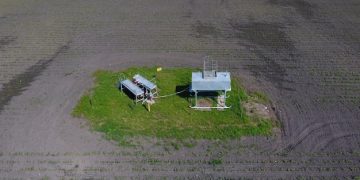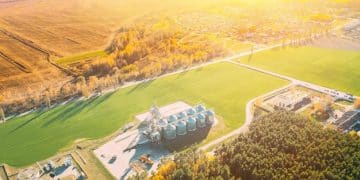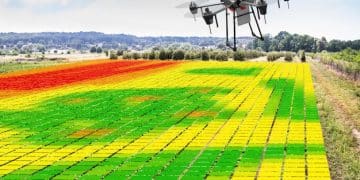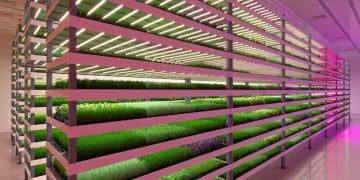US Agricultural Technology Adoption: Trends and Innovations
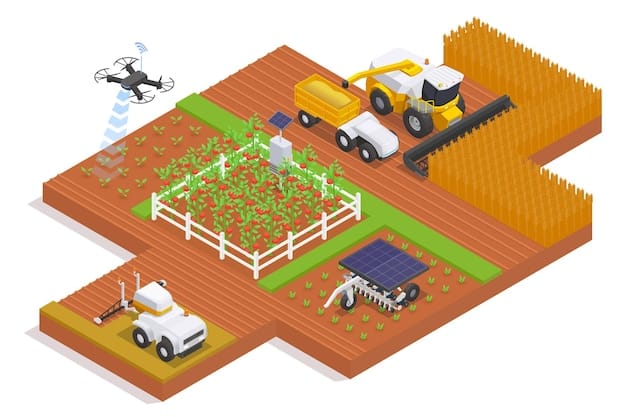
US Agricultural Technology Adoption is increasingly shaped by precision farming, automation, and data analytics, leading to greater efficiency and sustainability in the agricultural sector.
The landscape of US Agricultural Technology Adoption is rapidly evolving, driven by the need for increased efficiency, sustainability, and resilience in the face of growing global demands and environmental challenges.
Understanding the Drivers of AgTech Adoption in the US
Several factors drive the adoption of agricultural technology in the United States. Economic pressures, environmental concerns, and the increasing demand for food are among the primary motivators. Farmers are seeking ways to optimize their operations, reduce costs, and minimize their environmental impact.
Technological advancements, government policies, and the availability of funding and support programs also play a crucial role in shaping the adoption landscape. Understanding these drivers is essential for stakeholders looking to promote and facilitate the integration of
precision agriculture and other innovative solutions.
Economic Pressures
Farmers face constant pressure to increase yields and reduce costs. Technologies that offer the potential to improve efficiency and profitability are highly attractive. Precision agriculture, for example, can optimize inputs such as fertilizers and pesticides, reducing waste and increasing productivity.
Environmental Concerns
Sustainable farming practices are becoming increasingly important. Technologies that help minimize environmental impact, such as those that reduce water usage or promote soil health, are gaining traction. Consumers are also demanding more sustainable products, adding further incentive for farmers to adopt eco-friendly technologies.

Government Support and Policies
Government agencies and organizations offer various support programs and initiatives to encourage the adoption of agricultural technology. These programs may include funding for research and development, tax incentives, and technical assistance for farmers looking to implement new technologies. Such support is critical in accelerating the pace of adoption.
In conclusion, the push for efficiency, sustainability, and government incentives are key propellers in the adoption of AgTech in the US, making it crucial for farmers to stay informed and adaptable.
Precision Agriculture: Optimizing Crop Management
Precision agriculture involves using data and technology to optimize crop management practices. This approach allows farmers to tailor their inputs and activities to the specific needs of different areas within their fields, maximizing efficiency and minimizing waste. Key tools include GPS-guided machinery, remote sensing, and data analytics platforms.
The goal of precision agriculture is to improve decision-making and resource utilization, leading to higher yields, reduced costs, and a more sustainable farming operation. By leveraging these technologies, farmers can achieve better outcomes and adapt to changing conditions more effectively.
- GPS-Guided Machinery: Allows for precise application of inputs, reducing overlap and waste.
- Remote Sensing: Provides data on crop health, soil conditions, and other factors, enabling targeted interventions.
- Data Analytics Platforms: Integrate data from various sources to provide actionable insights and support decision-making.
Precision agriculture is transforming how farmers manage their crops, offering new opportunities to optimize their operations and improve their bottom line. As technology continues to advance, the potential for further gains in efficiency and sustainability is immense.
Automation in Agriculture: Streamlining Operations
Automation is playing an increasingly significant role in agriculture, with robots and automated systems taking on a wide range of tasks. From planting and harvesting to weeding and spraying, automation technologies are helping farmers reduce labor costs, improve efficiency, and increase productivity. These solutions are particularly valuable in addressing labor shortages and improving working conditions.
The adoption of automation technologies can lead to significant improvements in farm operations, allowing farmers to focus on higher-level decision-making and strategic planning. As the technology becomes more affordable and accessible, its adoption is expected to continue to grow.
Robotic Harvesting
Robots are being developed to automate the harvesting of various crops, including fruits, vegetables, and row crops. These robots use advanced sensors and algorithms to identify and pick ripe produce, reducing labor costs and minimizing waste.
Automated Weeding
Automated weeding systems use computer vision and robotics to identify and remove weeds from fields. These systems can operate continuously, reducing the need for manual labor and minimizing the use of herbicides.
Drone Technology
Drones are being used for a variety of tasks, including crop monitoring, spraying, and planting. They provide real-time data on crop health and soil conditions, allowing farmers to make informed decisions and respond quickly to problems.
In conclusion, automation is revolutionizing agricultural practices by improving production efficiency, reducing labor dependency, and promoting sustainable farming.
Data Analytics and IoT: Enhancing Decision-Making
Data analytics and the Internet of Things (IoT) are transforming agriculture by providing farmers with real-time data and insights to enhance decision-making. IoT devices, such as sensors and weather stations, collect data on various factors, including soil moisture, temperature, and humidity. This data is then analyzed using advanced analytics tools to provide farmers with actionable information.
By leveraging data analytics and IoT, farmers can make more informed decisions about irrigation, fertilization, and pest control, leading to improved yields and reduced costs. These technologies also enable more sustainable farming practices by optimizing resource utilization and minimizing environmental impact.
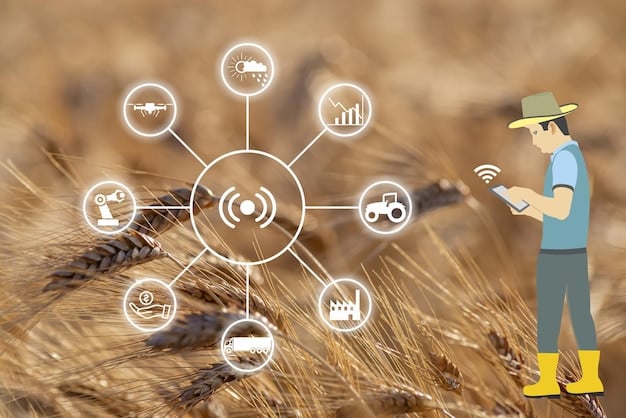
- Real-time Monitoring: IoT sensors provide continuous data on crop and soil conditions, enabling timely interventions.
- Predictive Analytics: Data analytics tools can predict potential problems, such as disease outbreaks or nutrient deficiencies, allowing farmers to take proactive measures.
- Improved Decision-Making: Data-driven insights enable farmers to make more informed decisions about crop management and resource allocation.
Data analytics and IoT are empowering farmers to optimize their operations and improve their bottom line. As these technologies become more sophisticated and affordable, their adoption is expected to continue to grow, driving further innovation in agriculture.
Challenges and Opportunities in AgTech Adoption
Despite the potential benefits of agtech, several challenges can hinder its adoption. These include the high upfront costs of many technologies, the lack of technical expertise and training among farmers, and concerns about data privacy and security. Overcoming these challenges is essential to ensure widespread adoption of agtech and realize its full potential.
However, the opportunities for growth and innovation in agtech are immense. As technology continues to advance and become more affordable, agtech is poised to transform agriculture, leading to more efficient, sustainable, and resilient farming systems.
High Upfront Costs
Many agtech solutions require significant investments in equipment, software, and infrastructure. This can be a barrier for small and medium-sized farmers who may not have the financial resources to adopt these technologies. Innovative financing models and government support programs can help address this challenge.
Technical Expertise and Training
Farmers need to have the technical skills and knowledge to effectively use and maintain agtech solutions. This requires access to training programs and technical assistance. Partnerships between universities, industry, and government can play a crucial role in providing farmers with the necessary skills.
Data Privacy and Security
As agtech solutions generate vast amounts of data, concerns about data privacy and security are growing. Farmers need to be assured that their data is protected and used responsibly. Clear data governance policies and cybersecurity measures are essential to build trust and encourage adoption.
In addressing these challenges, there is an opportunity for the US to lead in AgTech, through innovation, policy and strategic investment.
The Future of Agricultural Technology in the US
The future of agricultural technology in the US is bright, with ongoing advancements in areas such as artificial intelligence, biotechnology, and robotics. These technologies are expected to further transform agriculture, leading to more efficient, sustainable, and resilient farming systems. Collaboration between researchers, industry, and government will be essential to drive innovation and ensure that agtech benefits all farmers.
As the global population continues to grow and climate change poses increasing challenges, the role of agtech in ensuring food security and environmental sustainability will become even more critical. By embracing these technologies, the US can remain a leader in agriculture and help address some of the world’s most pressing challenges.
- Artificial Intelligence: AI is being used to analyze vast amounts of data and provide farmers with actionable insights.
- Biotechnology: Advances in biotechnology are leading to the development of crops that are more resistant to pests, diseases, and environmental stresses.
- Robotics: Robots are taking on more tasks in agriculture, further reducing labor costs and improving efficiency.
The continued investment in agtech will drive future innovation in the sector, and is likely to reshape the farming landscape in profound ways.
| Key Point | Brief Description |
|---|---|
| 🌱 Precision Agriculture | Optimizes crop management through data-driven insights and GPS technology. |
| 🤖 Automation in Agriculture | Streamlines operations with robots and automated systems for planting, harvesting, and weeding. |
| 📊 Data Analytics and IoT | Enhances decision-making with real-time data collected via sensors and analyzed through IoT platforms. |
| 🌍 Sustainability | AgTech promotes sustainable farming practices, reducing environmental impact and conserving resources. |
Innovation and Sustainable Practices
▼
The main drivers include economic pressures to increase yields, environmental concerns promoting sustainable practices, and government support through policies and funding.
▼
Precision agriculture uses data and technology like GPS-guided machinery and remote sensing to tailor inputs and activities to specific needs within fields.
▼
Automation streamlines operations by using robots for tasks like harvesting and weeding, reducing labor costs and improving efficiency in the fields.
▼
Data analytics and IoT provide real-time data through sensors and weather stations, enabling informed decisions about irrigation, fertilization, and pest control.
▼
Challenges include high upfront costs, the need for technical expertise, and concerns about data privacy, all of which can hinder widespread adoption among farmers.
Conclusion
In conclusion, the adoption of agricultural technology in the US is driven by the need for increased efficiency, sustainability, and resilience. Innovations in precision agriculture, automation, data analytics, and IoT are transforming the farming landscape, offering new opportunities for farmers to optimize their operations and improve their bottom line. While challenges such as high costs and data privacy concerns remain, the future of agtech in the US is promising, with ongoing advancements poised to drive further innovation and ensure food security and environmental sustainability.
